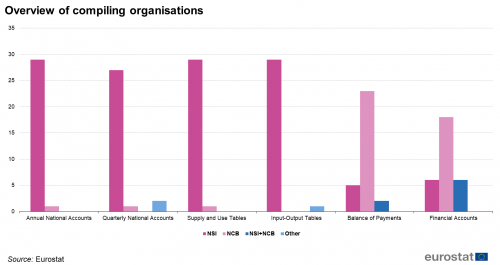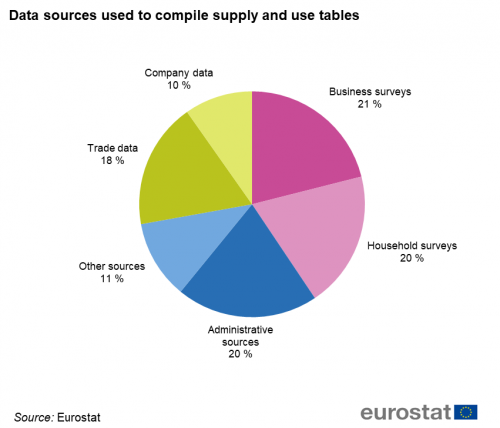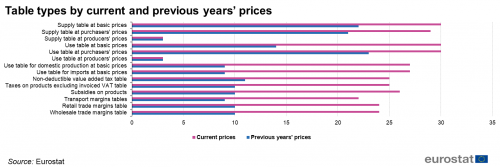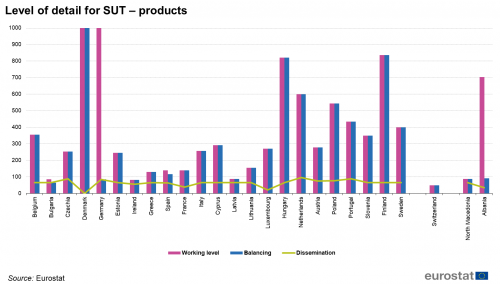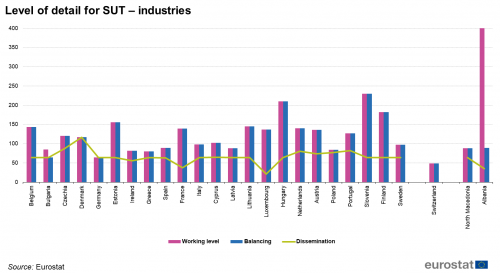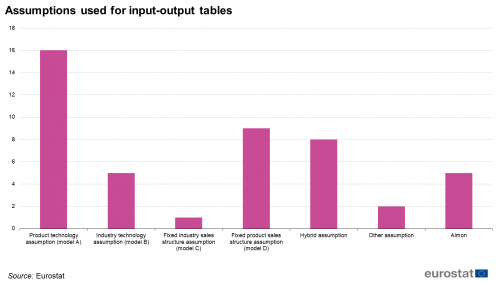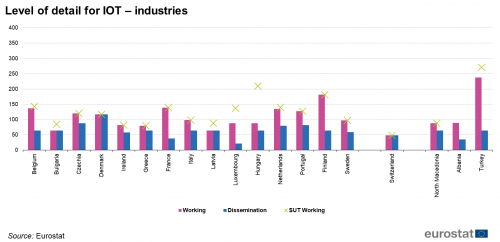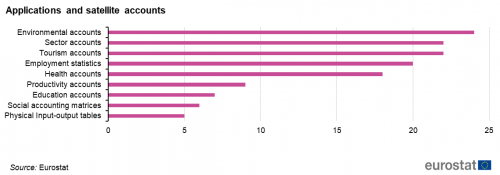Review of national supply, use and input-output tables compilation
In February 2019, Eurostat launched a questionnaire on the compilation of national supply, use and input-output tables. The purpose of the survey was to update information from the 2014 questionnaire, the first survey on this subject, and to collect new data on some additional aspects related to SUIOTs. The questionnaire covered the following areas:
- a) organisation;
- b) main data sources for compiling supply and use tables and input-output tables;
- c) statistical units and classifications;
- d) supply and use tables;
- e) input-output tables;
- f) production environment;
- g) dissemination; and
- h) applications/systems.
In total, 31 countries, including 26 EU Member States, provided replies. These countries are listed below, in alphabetical order: Albania, Austria, Belgium, Bulgaria, Croatia, Cyprus, Czechia, Denmark, Estonia, Finland, France, Germany, Greece, Hungary, Ireland, Italy, Latvia, Lithuania, Luxembourg, Malta, the Netherlands, North Macedonia, Poland, Portugal, Romania, Slovenia, Spain, Sweden, Switzerland, Turkey and the United Kingdom. Five countries (Albania, Bulgaria, Cyprus, Greece and Spain) did not participate in the 2014 questionnaire.
Full article
Organisation of National Accounts at national level
Compilation of annual and quarterly national accounts is the responsibility of national statistical institutes. The one exception is Belgium. In Belgium, the national accounts are published by the National Accounts Institute. The Institute, which was created by a law dated December 1994, is a cooperative venture between three partners: Statistics Belgium, the National Bank of Belgium and the Federal Planning Bureau. Statistics Belgium is in charge of business statistics and the collection of survey data used in compiling national accounts. The National Bank of Belgium is responsible for the compilation of institutional sector accounts, annual and quarterly national accounts, regional accounts and supply and use tables. In Austria the quarterly National Accounts is compiled by the NSI and by the Austrian Institute of Economic Research. In Switzerland, the quarterly national accounts are compiled by the State Secretariat for Economic Affairs (SECO).
With exception of Belgium, supply, use and input-output tables are also compiled by national statistical institutes (NSIs). In Belgium, the National Bank of Belgium is responsible for supply and use tables, while the Federal Planning Bureau is in charge of the five-yearly input-output tables. The Federal Planning Bureau also contributes to the compilation of supply and use tables for the years when the input-output tables are compiled.
When looking at compilation of balance of payments and financial accounts data, most countries reported that the data are compiled by their national central banks (NCBs). In Austria and Luxembourg, balance of payments data are compiled through cooperation between the central bank and national statistics institute; in Czechia, Cyprus, Denmark, Estonia, Luxembourg and Poland, the central bank and national statistics institute collaborate to compile financial accounts data. In Finland, Ireland, Sweden and the United Kingdom, national statistics institutes are responsible for balance of payments data, while in Finland, Ireland, Lithuania, the Netherlands, Sweden and the United Kingdom, national statistical institutes also compile the financial accounts.
Annex 1 (see excel file under Source data for tables, figures and maps (MS Excel) provides a list of contact persons for National Accounts and SUIOTs.
Figure 1 illustrates how National Accounts work is shared out between the compiling organisations.
Main data sources used to compile supply and use tables
The compilation of supply and use tables is based on a large number of different input data. Although the descriptions of data sources used in countries seem to be similar, they may vary significantly in frequency and coverage. The situation is more comparable for data where collection is regulated by EU law applicable to Member States, e.g. the Structural Business Survey, balance of payments, Intra-EU and Extra-EU trade in goods and different price indices. Therefore, it is important for users to have more background information about base data used in the compilation process as it helps them to understand better the context in which these tables are created.
In the questionnaire, countries were asked to provide information about business and household surveys, trade data, administrative sources and price indices used (see Figure 2).
When looking at business surveys mentioned in the questionnaire, about half of the countries (14) use annual structural business statistics (SBS) for SUT compilation — SBS provides data for industry, construction, trade and services. One third of countries use Prodcom (data on production of industrial goods) and different construction-related surveys. Various investment surveys (mentioned by 7 countries) and R&D-related data (5 countries) are also important data sources. Other business surveys noted by countries are energy-related surveys and the Labour Cost Survey.
The Household Budget Survey (HBS), used in 25 countries, is the most important data source for private consumption-related estimates. Quarterly HBS data are available in Bulgaria, Czechia, Hungary and North Macedonia, while in other countries (multi-)annual surveys are carried out. In addition to HBS, data from population censuses, the Labour Force Survey and surveys related to tourist expenditure are used for SUTs.
In their replies, 17 countries cited various government-related data, e.g. on budget execution, education and social security. More and more countries have access to detailed information on various taxes and use these data in the compilation process. A total of 11 countries make use of information on VAT data, while 9 respondents mentioned other taxes such as private income tax or corporate tax.
Balance of payments and Intra-EU and Extra-EU trade in goods are the most mentioned sources under trade data (15 and 11 countries respectively). In addition, international trade in goods (ITGS) and in services (ITSS), customs data, etc. are used to estimate exports and imports in supply and use tables.
In 13 out of the 31 countries who replied to questionnaire, company data is used for SUIOT compilation, including data from multinational enterprises (MNEs). Austria, Estonia, Finland, Hungary, Latvia and Slovenia use annual reports, balance sheets and profit and loss accounts available to the public in the business register or over the internet. These data are used either for direct compilation or for controls and balancing. Luxembourg makes direct use of accounting documents for certain large service enterprises (like the railways, postal services and telecommunications, radio and television, air transport, satellite operations, casinos/gambling) and for market and non-market public units, as such enterprises and units are not included in the government accounts. Belgium uses company data to compile detailed national accounts by industry and also uses them for SUIOTs, especially for industries where multinational enterprises have a significant presence. In Ireland, company data are used only occasionally for SUIOT compilation to check the other sources.
In addition to the above, Denmark and the Netherlands make use of information available in their recently established large case units.
As of December 2018, EU Member States have an obligation to transmit, for reference year 2015 onwards, supply and use tables both at current and at previous years’ prices. Depending on the character of variables, different price indices are used for deflation. At present, about two thirds of countries already compile tables at previous years’ prices. In their replies, countries cited producer and consumer price indices, as well as export/import price indices (or unit value indices) and construction price indices, as the most widely used.
A comprehensive list of data sources by country can be found in Annex 2.
Statistical unit and classifications
According to ESA 2010, the transmission programme for the European system of national and regional accounts, supply and use tables transmitted to Eurostat use the Classification of Products by Activity (CPA 2008) for products and the Statistical Classification of Economic Activities in the European Community (NACE Rev 2) for industries. The latter is in line with the International Standard Industrial Classification of All Economic Activities (ISIC 4). Supply, use, and input-output tables are transmitted to Eurostat, with data broken down into 64 products and 64 industries.
All countries who contributed to the questionnaire are using NACE Rev 2 or its national adaptation for industries and the CPA for products. The level of detail can vary significantly between countries. Switzerland has the most aggregated versions, with 49 industries and products. A number of countries are using NACE up to 4-digit level and CPA up to 6-digit level.
Generally, data sources used to estimate final consumption expenditure are not available through NACE Rev 2 or CPA. Such data are instead collected according to classifications more suitable to describe their character. For example, HBS data are normally available in the Classification of individual consumption by purpose (COICOP). The Classification of the functions of government (COFOG) is used for government-related information, while the Classification of the purposes of non-profit institutions (COPNI) is used for non-profit institutions. Use of data in COICOP was mentioned by 22 countries, while 12 countries use source information available in COFOG.
For trade data, the Combined Nomenclature (CN) is mainly used; some countries (e.g. Slovenia and Lithuania) also mentioned Classification by Broad Economic Categories (BEC), which groups goods by end-use of product.
Depending on the data sources, the statistical unit used may differ. Therefore, some adaptations and harmonisations may be necessary before source data can be used to compile SUTs. (see Figure 3)
Table types
Transmission of data to Eurostat is a requirement laid down in the ESA 2010 transmission programme. Member States are required to transmit annually supply tables at basic prices, including transformation into purchasers’ prices and use tables at purchasers’ prices. In addition, for years ending with ‘0’ and ‘5’, Member States also have to transmit: (i) a use table at basic prices (including a split for domestic outputs and imports); (ii) a table of trade and transport margins; (iii) a table of taxes less subsidies on products; and (iv) input-output tables (see figure 4).
In all countries except Switzerland, supply and use tables are compiled annually, whereas in France, the Netherlands and Turkey quarterly SUTs are available. While supply tables are transmitted at basic and purchasers’ prices, only a few countries (e.g. Czechia and Poland) compile full tables at both price concepts. In most cases, valuation matrices are used to transform tables at basic prices into purchasers’ prices. Although tables at producers’ prices are not required under ESA 2010, some countries, e.g. Czechia and Greece, produce tables at this price concept as well.
While use tables at basic prices are required every 5 years, 16 countries already compile them annually. Users very much appreciate this higher frequency for tables at basic prices as these tables are a valuable source for country comparisons and analyses. For example, Eurostat makes a wide use of these tables in the context of EU inter-country supply, use and input-output tables (FIGARO [1]).
More detailed tables for transport margins, trade margins, subsidies or specific tables for taxes are compiled annually by about 20 countries, while 5 countries do so multi annually. Bulgaria, Czechia, Hungary and Portugal estimate retail and wholesale trade margins together, while in Sweden and Greece transport, retail and wholesale margins are included at aggregated level in the same table. In Turkey, tax matrices and trade margins are compiled as total taxes on products/margins for the benchmark year and as a product vector for the extrapolation years. In Denmark, a single table for taxes on products, net of subsidies, is compiled annually at current and previous year’s prices.
Not all countries compile supply and use tables at current and previous year's prices yet as some have been granted an exemption allowing them to start transmitting tables at the previous year’s prices by end-2020. However, the number of countries transmitting tables at both prices to Eurostat is constantly increasing.
On top of the tables referred above, France, Belgium and the United Kingdom also compile regional tables that are consistent with their national supply and use tables. In 2015, the Federal Planning Bureau in Belgium, in cooperation with the statistical authorities of Belgium’s three regions, constructed a 2010 interregional input-output table for Belgium. The estimation of a 2015 interregional input-output table is planned for 2020. France compiles tables annually at aggregated A10 level.
Supply and use tables
In Eurobase (the Eurostat database), supply and use tables are disseminated for 64 industries and products. However, most countries compile these tables at a much more detailed level and then aggregate them for dissemination purposes (see figure 6).
In all countries except Switzerland (which has 49 products in all stages), the number of products used at working level is significantly higher than the dissemination level. For example, Germany has 2 600 products, Denmark 2 350 and Turkey 2 466. Tables that are more aggregated but still above 64 products are compiled in Bulgaria (85 products), Ireland (82), Latvia (88) and North Macedonia (88). In many countries, the same level of detail is also used for balancing, but for dissemination the number of products is reduced significantly. Still, 5 countries (Austria, Czechia, Germany, the Netherlands and Portugal) publish supply and use tables at a more detailed level than in the tables transmitted to Eurostat. In contrast, in SUTs disseminated for Albania, France, Ireland and Luxembourg, products are aggregated to a higher level than the legal requirements in ESA 2010. One of the main reasons cited by countries to explain this is the confidentiality of individual data. This applies especially to smaller countries, where the identity of data providers has to be protected.
For Denmark, the number of products for national dissemination is missing as SUTs are published only via the Eurostat webpage.
Compared to products, industries are less detailed in many countries, but in most cases still well above the legal requirement of 64 industries (see figure 7). In Bulgaria, France, Ireland, Latvia, North Macedonia and Switzerland, the level of details for products and industries the level of details for products and industries is the same.
Having rectangular tables with more products than industries is recommended practice as it ensures that products included in the same group are more homogenous. Level of detail for industries is also important, but there is probably less need to have the same disaggregation as for products.
Analysts and researchers are always looking for most recent available data and for the longest possible time series. EU Member States have to provide data at the latest T+36 months after the reference period. For that reason, users often consider that supply and use tables become available too late. The time taken to compile tables can vary significantly, depending on a specific country’s compilation system and on whether the supply and use tables are integrated into national accounts and form bases of estimates. In Czechia, the Netherlands and France, the first tables become available 5-6 months after the reference period. In Luxembourg, the first version of the SUT is accessible 12 months after the end of the reference period, while for Portugal the time lag is 21 months, and for Finland and Sweden 24 months. For other countries, it remains between 30 and 39 months. While compilation of SUTs is time consuming and requires many resources, five countries (Czechia, France, Luxembourg, the Netherlands and Switzerland) actually compile several versions of these tables.
As described in the UN Handbook on Supply, Use and Input-Output Tables with Extensions and Applications, many countries compile SUTs as part of their ‘core’ national accounts as it improves the consistency and coherence of estimates. In all countries except Latvia, estimates for main aggregates are consistent with SUTs, at least at a certain point in time. In Czechia and Italy, SUT and main aggregates are always aligned, as both sets of data are compiled in the same process. Due to changes or improvements in source data, national accounts estimates are regularly revised. As compilation of SUTs requires many resources, not all countries revise these tables after revisions in the main aggregates. However, about one third of countries confirmed that two datasets are aligned also after revisions in main aggregates (see figure 8).
While first estimates of GDP are produced much earlier than SUTs become available, more than two thirds of countries use SUT tables for their GDP estimates. SUTs are mainly used for the production and expenditure approach, with 10 countries also mentioning an income approach.
As described above, supply and use tables are based on information from miscellaneous data sources, with the result that data for supply and use are often unbalanced. All countries use manual balancing, at least for bigger and significant inconsistencies, which require additional investigation (e.g. problems in source data). Some 20 countries also apply automatic balancing, which is often used for remaining, rather small inconsistencies. The most widely used technique is RAS. In Italy, balancing issues are solved automatically using the Stone, Champernowne and Meade (1942) approach, integrated with the conjugate gradient method, an algorithm for solving the problem of balancing large accounting systems. A certain amount of cells are not allowed to change in the automatic balancing process. In Denmark, whenever a cell is balanced manually, the balancing software does some subsequent automatic balancing under the supervision of the person doing the balancing. Previously, those cells would have had to be balanced manually as well.
In countries where both tables at current and previous years’ prices are compiled, either sequential or simultaneous balancing can be used. In the case of sequential balancing, tables at current prices are first balanced then deflated; after that, SUTs at previous years’ prices are balanced. Where simultaneous balancing is used, tables at both prices are balanced at the same time. Of the 23 countries who replied to this question, 15 are using sequential balancing and 8 simultaneous balancing. Both methods have their advantages and disadvantages; these are explained in more detail in the Handbook on Supply, Use and Input-Output Tables with Extensions and Applications.
From our point of view, it is interesting to know what resources countries devote to compiling SUTs and how long the compilation takes them, but it proved difficult for compilers to reply to these questions. The time between the start of SUT compilation and the start of balancing varies from 1 month in Czechia and Greece to up to 18 months in some other countries. In 8 countries, it takes between 1 and 3 months to compile tables, while about 10 countries need 4-6 months to complete the compilation process. Also, the time taken to perform the balancing differs significantly between countries, ranging from 1 week in Luxembourg and Italy to 4 months in Hungary, 5 in Cyprus and 6 months in Denmark. This information is not really comparable between countries as it depends on: (i) the production system in each country (e.g. integration between regular national accounts production and SUTs); and (ii) the allocation of staff to compile these tables. France was the only country to mention people working full time on SUTs (1 for quarterly tables and 1 for annual tables). In all other countries, the staff involved in the compilation process also have other tasks during the year.
Compilation of additional information
The compilation of supply and use tables ‘hides’ a lot of additional information assembled for a specific item in tables. For example, in 19 countries detailed tables for private household consumption are prepared, often using the detailed COICOP classification; these first have to be converted to the CPA classification before the data can be used to compile the use table. For this purpose, cross-classification tables specific for each country are used. Similarly, 9 countries prepare detailed tables for government consumption using the COFOG classification, while 14 countries prepare investment matrices or commodity flows. Within the SUT framework, Denmark compiles a table of 117 delivering industries, broken down by 13 different investment categories, while Finland uses 836 products and 182 industries in its compilation of the tables. In Estonia, an investment matrix of 150 activities is used.
About half of the countries provide an estimate by product of direct purchases abroad by residents and purchases on the domestic territory by non-residents. This information is necessary to adjust data to the domestic concept used in supply and use tables for products. For example, in the Netherlands, purchases of non-residents are estimated by product, while purchases of residents abroad are only estimated by product for business travel. In Lithuania, only services connected with tourism are taken into account, while in Greece these expenditures are estimated for 130 products.
A total of 24 countries break down their imports by different categories. Breakdowns by goods and services and by geographic origin are the most commonly used. Hungary also makes data available on inward and outward processing, while Slovenia makes available merchanting and processing data. In all countries, data on imports are available in cost, insurance and freight (CIF) valuation. In four countries (Czechia, Denmark, Latvia and Switzerland), no adjustment is carried out for imports to free on board (FOB). In Czechia, adjustment is carried out only in SUTs that are transmitted to Eurostat.
Some 20 countries agreed to have a treatment for missing data. For example, in Romania the structural business survey team takes care of the missing data, while in Czechia estimates for non-observed economy are taken over from sectoral accounts. Some countries, like Finland, estimate missing data by applying the commodity flow method.
Input-output tables
Input-output tables (IOTs) are compiled in all countries. Annual tables are produced in 12 countries (e.g. Austria, Cyprus, Denmark, Finland, France, Italy, Luxembourg, the Netherlands and Sweden), while the rest have multi-annual tables, normally for reference years ending with ‘0’ or ‘5’, as required by the ESA 2010 transmission programme. A total of 26 countries compile product-by-product tables, as required by the transmission programme, and 11 countries compile industry-by-industry tables. Albania, Belgium, Czechia, Hungary, Italy and Sweden compile IOTs both product-by-product and industry-by-industry.
In 29 countries, IOTs are the result of the transformation of supply and use tables. The Eurostat Manual of Supply, Use and Input-Output Tables lists four main assumptions for transformation:
- a) product technology assumption (Model A);
- b) industry technology assumption (Model B);
- c) fixed industry sales structure assumption (Model C); or
- d) fixed product sales structure assumption (Model D).
Based on the results of the questionnaire (see figure 9), Model A is the most widely used assumption for product-by-product IOTs, while for industry-by-industry tables Model D is the most widely used. Belgium, France, Ireland, Luxembourg, the Netherlands, Portugal and the United Kingdom use a hybrid assumption where the product and industry technology assumptions are combined in order to avoid negatives in transformed tables. Austria, Estonia, Latvia, Switzerland and Turkey use the Almon procedure, which can also be used to avoid negatives in product-by-product IOTs.
In Czechia, Cyprus, Denmark, Finland, France, Greece, Ireland, Lithuania, North Macedonia, Portugal, Sweden and Switzerland the product detail used in IOTs equals to that used for supply and use tables at working level (see figure 10). For Denmark and the Netherlands dissemination information is missing as these countries transmit only industry-by-industry tables.
Czechia, Denmark, Greece, Finland, France, Ireland, Italy, North Macedonia and Switzerland use the same level of industry detail in input-output tables as in the supply and use tables (see figure 11).
In the Netherlands, the input-output tables are disseminated at the same time as SUTs, i.e. 6 months after the end of the reference period. Denmark disseminates 10 months after the reference year, and Luxembourg does so 12 months after. In Czechia, Finland and Sweden, IOTs become available after 24 months. France and Slovenia publish at T+30 months, which is still ahead of the legal requirement of T+36. Only four countries (Denmark, Luxembourg, the Netherlands and the United Kingdom) revise their initial IOTs.
Production and dissemination of SUIOTs
Production environment One part of the questionnaire was dedicated to production and dissemination environments. Excel is still the main tool used for production (mentioned by 29 countries), although databases (13 countries) and statistical packages (e.g. SAS or similar packages) are also used (12 countries). Belgium, Cyprus, the Netherlands and the United Kingdom have mentioned databases developed in-house.
Over the last few years, Eurostat has worked with Member States on a validation framework for incoming data. The main aims of this work are to increase the quality of incoming data and detect problems in data (e.g. inconsistencies within or between tables and domains) as early as possible. Different national accounts domains have laid down a number of validation rules; these are all gathered in the ESA 2010 Handbook on Data Validation and, more importantly, are implemented in the IT systems countries use to transmit data. In the last few years, all SUIOT data transmitted to Eurostat have been validated against these rules. The quality of incoming data has increased since the framework was put in place. A total of 19 countries have confirmed that validation rules are applied before transmitting data to Eurostat, while Belgium, Czechia, Cyprus, Ireland, Luxembourg, Portugal and Slovenia have already implemented them in their production system.
There are 15 countries that apply some confidentiality rules to supply and use tables. The main reason is the identification of individual data.
On quality assessment, 24 countries assess the quality of their data nationally. A national code of practice is applied in 21 countries, while Cyprus and Greece apply certain provisions of the European Code of Practice.
Dissemination of SUIOTs
All data transmitted to Eurostat are disseminated in Eurobase, but almost all countries also have national publications. The most common method to disseminate SUTs is via Excel files (23 countries), followed by web-based databases (10 countries), download possibilities in different formats (five countries). Four countries mentioned also e-mail service to some users and three countries online publications and pdf versions of downloaded data.
One outcome of the questionnaire is a collection of web page addresses, which can help users to find information about SUTs, IOTs and other information disseminated by countries (e.g. metadata, data analyses). See Annex 3 for a full list of these addresses.
Only 8 countries (including Albania, Austria, Hungary, Ireland, the Netherlands and Slovenia) analyse the main users of the data. Ireland analyses the data through web analysis and email conversations, which also provide an opportunity to discuss with the liaison group of macroeconomic users. Slovenia relies on researchers at universities, research institutes and governmental economic analysis offices to carry out the data analysis.
'Applications and satellite accounts Many countries compile various applications of tables and satellite accounts. (see figure 12). Full list by country is available in Annex 4.
Source data for tables and graphs
Data sources
The data presented here are based on a questionnaire addressed to European Member States in 2019. Data have been compiled during the year 2019.
Context
Eurostat has carried out a survey to update information concerning compilation of supply and use, input-output tables Eurostat is thankful to all countries who have replied to its request.
Direct access to
- Supply, use and Input-output tables (naio_10_cp)
- FIGARO tables: EU inter-country supply, use and input-output tables.
- Regulation (EU) No 549/2013 of 26 June 2013 on the European system of national and regional accounts in the European Union
- Summaries of EU Legislation: European Union system of national and regional accounts
